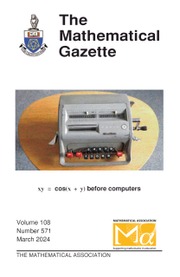No CrossRef data available.
Article contents
The inradii of convex circumgons
Published online by Cambridge University Press: 15 October 2025
Extract
In Euclidean geometry, a tangential polygon or a circumgon is a polygon that contains an inscribed circle which is also called an incircle and the radius of its incircle is called the inradius. A tangential polygon may be concave or convex. If it is concave, it is the extension of some of its sides that is tangent to the incircle. In this Article we restrict ourselves to convex tangential polygons, so that their corresponding incircles are tangent to each of its sides. Every regular polygon is a circumgon and there are also irregular polygons that are circumgons but not all irregular polygons are circumgons. In what follows, we shall use circumgon or tangential polygon interchangeably according to the situation.
Information
- Type
- Articles
- Information
- Copyright
- © The Authors, 2025 Published by Cambridge University Press on behalf of The Mathematical Association


